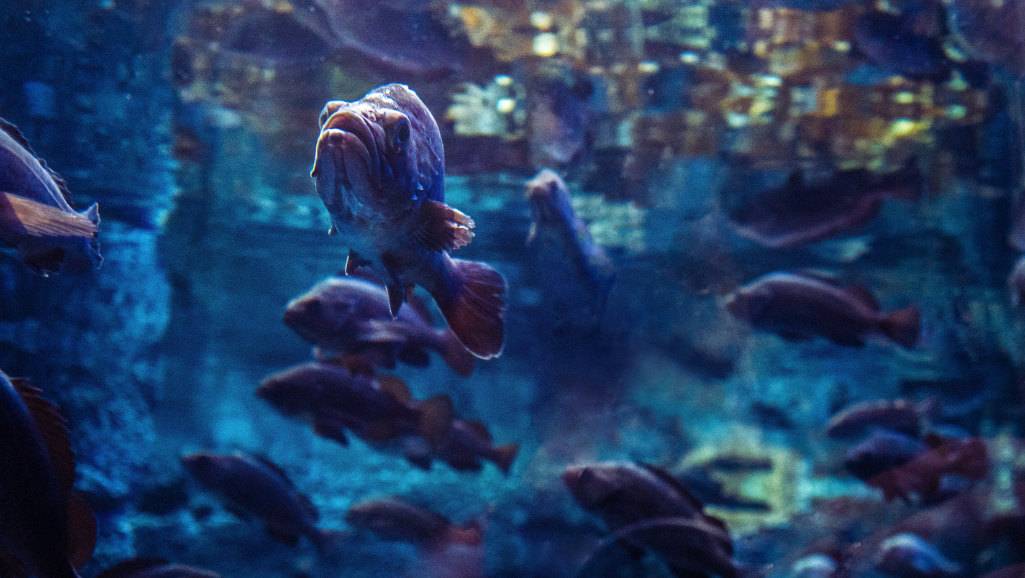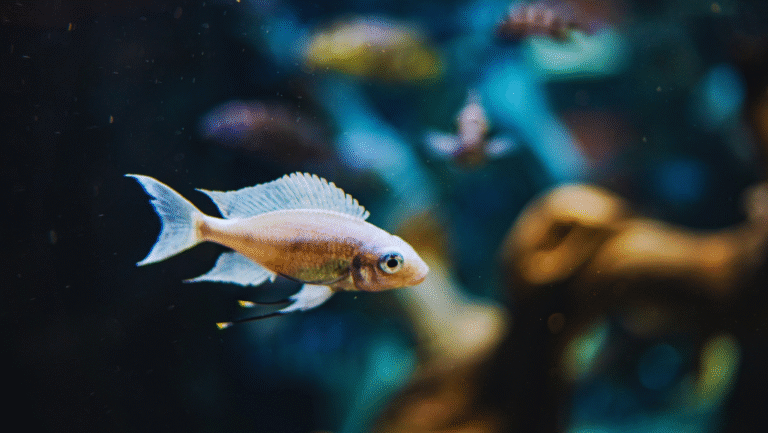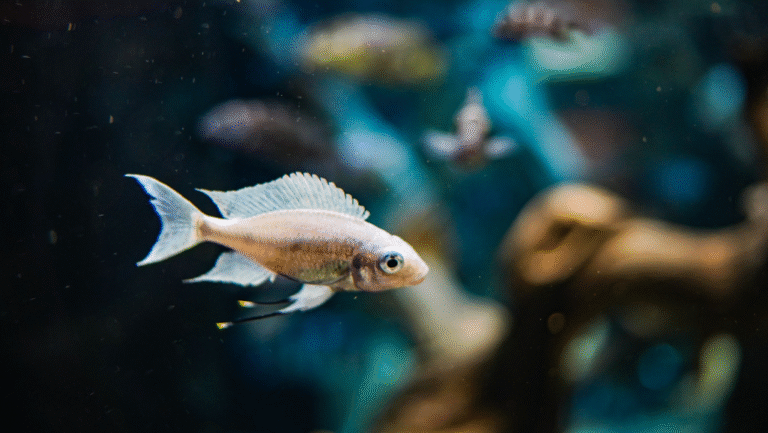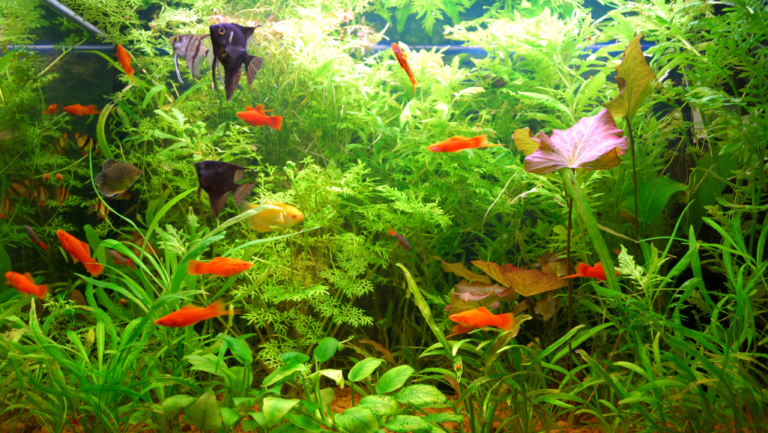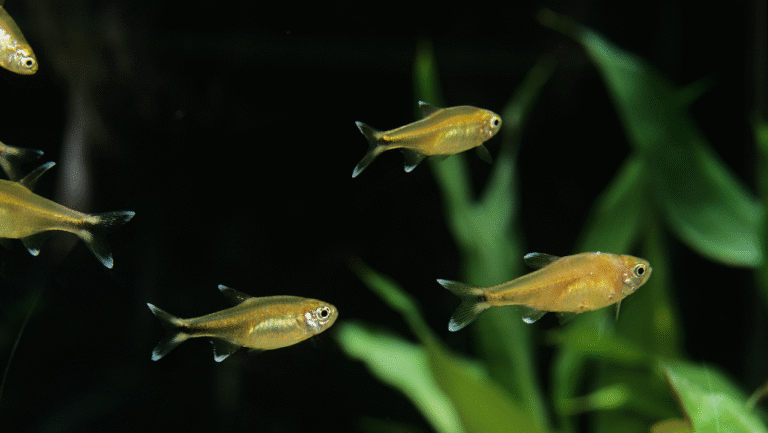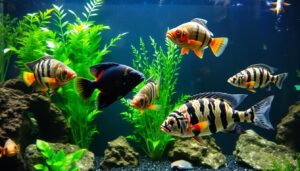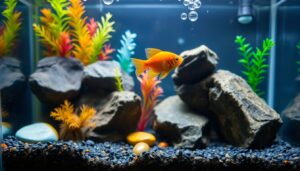Exploring the world of grand tanks shows it’s more than a hobby—it’s an art. This guide helps you create a green space with best fish for large aquariums. It shows how to enjoy fishkeeping in a cool environment without harming the planet.
Starting a greener hobby is a personal journey. Imagine a tank full of life: Rosy barbs swimming in a 90cm tank for just £3.50. Or Florida flagfish in a 75cm tank. These fish are more than pets; they’re part of a green lifestyle, thriving in cooler waters.
Changing fish to cooler waters is done slowly to avoid stress. This makes fishkeeping more than just keeping fish. It’s about creating a beautiful, eco-friendly space. The Fluval Roma 240’s design and its lighting and filter system help make this possible.
Check out the top 40 coolest freshwater aquarium fish for grand tanks. Also, learn about fish size to keep your tank healthy and beautiful.
Key Takeaways
- The Ultimate Guide to aquarium fish large for Your Tank.
- Grand tanks create an awe-inspiring spectacle with environmental and economic benefits.
- Opt for fish like Rosy barbs and Florida flagfish to establish a temperate freshwater tank.
- Gradual acclimation of tropical fish to cooler temperatures is crucial for their well-being.
- Large aquariums require careful planning for space, such as for the active Zebra danios in 122cm tanks.
- Investing in quality equipment, such as the Fluval Roma 240, ensures a stable and thriving environment for large fish species.
- Understanding fish growth and stocking levels is essential for a balanced and visually appealing aquarium.
- Researching and preparing for the challenges of breeding and caring for large fish is key to successful fishkeeping.
Understanding the Allure of Large Aquarium Fish
The world of large aquarium fish is full of beauty and interesting behaviors. These fish add life and color to any space. They are great for both new and experienced fish keepers, making any room special.
The Aesthetic Impact of Majestic Swimmers
Large aquarium fish are truly beautiful. Fish like Giant Gouramis and Silver Arowanas are like living art. They move gracefully and add life to their tanks.
Having a big tank lets these fish show off more. It makes their movements look even more stunning. Watching them can also help reduce stress and make a room feel peaceful.
Behavioral Characteristics of Large Fish Species
Each large fish species has its own way of acting and swimming. Fish like Red Tail Catfish and Flowerhorn Cichlids are fun to watch. They interact with each other in interesting ways.
For beginners, starting with large fish can be very rewarding. Places like ThienDuc Aquarium offer many species and advice. This helps beginners enjoy their fish without feeling too stressed.
Big tanks are also easier to keep clean and stable. This is great for new fish keepers. They can learn about many different fish species, which helps them grow in their hobby.
The beauty of large aquarium fish is not just visual. It also engages the mind. It offers endless learning and relaxation opportunities.
Starting a hobby with large tank fishkeeping is both rewarding and beautiful. It’s a great choice for people from all backgrounds.
The Essentials of Setting Up a Large Aquarium
Starting a large fish tank is both thrilling and challenging. It requires careful planning and the right tools. This part covers the basic steps to create a great home for large fish for fish tank.
Selecting the Right Tank Size for Your Big Aquarium Fish
For large fish, bigger tanks are usually better. Big fish need lots of space to swim and act naturally. Experts say to have at least 10 gallons per inch of fish to keep them healthy. Sales like Petco’s offer big tanks at low prices, making it easier to get the right size.
Crucial Equipment for a Successful Grand Tank
For a great home for large aquarium fish care, you need some key items:
- Filtration System: Good water quality is key. Filters should clean three to five times the tank’s volume each hour. This helps manage the extra waste big fish make.
- Heating: Keeping the water at the right temperature is vital. Heaters should give 3-5 watts per gallon. This keeps the water between 72–82°F, which most fish like.
- Lighting: Right lighting keeps the fish healthy and makes the tank look good. Fish-only tanks need 1-2 watts per gallon. Plants might need 2-5 watts, depending on the type.
- Substrate and Decorations: Substrates help with filtering, and decorations give fish places to hide. They also make the tank look nice.
Also, keeping the tank clean is crucial. Use tools like siphons, test kits, and dechlorinators to keep the water safe and healthy for the fish.
By meeting the needs of large aquarium fish types and caring for them well, you can create a stunning large aquarium. This ensures your fish stay healthy and happy for a long time.
Aquarium Fish Large: Choosing the Right Species for Your Tank
Choosing the right top large aquarium fish species is key for a thriving tank. It’s important to pick fish that get along well and fit your tank’s size. This guide will help you pick the best popular big fish for aquarium setups, focusing on how they get along, their size, and how they look.
Large fish like the Arowana or Kissing Gouramis add color and charm to your tank. They need special care that matches your tank’s conditions. For more on fish care, check out this resource.
Big fish need lots of space to swim and avoid stress. For example, Oscars and Arowanas grow a lot. They need room to swim without getting sick. Also, some fish like the Giant Gourami like a calm place but still need their own space.
Here are some tips to make sure your popular big fish for your aquarium thrive:
- Research before purchasing: Know the fish’s full adult size and how it acts.
- Consider tankmates carefully: Some fish, like Tetras and Barbs, need to be in groups to feel safe and happy.
- Plan for growth: Make sure your tank is big enough for the fish when it grows up. Too many fish can make them sick.
- Adjust the habitat: Change your tank’s layout when you add new fish. This helps them not fight over territory.
| Fish Type | Group Size Recommendation | Typical Adult Size | Water Condition Preference |
|---|---|---|---|
| Tiger Barbs | School of 6+ | Up to 3 inches | Freshwater; Moderate pH levels |
| Discus | School of 5+ | Up to 8 inches | Soft, acid water; high cleanliness |
| Clown Loaches | Group of 5 or more | Up to 12 inches | Tropical freshwater; cave-rich environment |
| Kissing Gouramis | Group of 3+ | Up to 12 inches | Warm, slightly acidic to neutral water |
Choosing the right large tropical fish for aquariums is more than just picking the biggest or most colorful. It’s about creating a balanced environment where all fish contribute to a healthy ecosystem. By following these tips and planning your tank carefully, your large aquatic pets will thrive. They will add beauty and life to your home or office.
Designing a Habitat: Decor and Space for Large Fish
Creating a perfect home for large aquarium fish is more than just knowing their needs. It’s also about adding large fish tank decor ideas that make their space beautiful. A well-designed habitat not only keeps fish healthy but also makes your aquarium a stunning part of your home or office.
In large aquarium fish decor, picking the right plants and substrates is key. Plants like Vallisneria and Java fern are great because they’re tough and easy to care for. They’re perfect for big fish that move a lot. Substrates help the ecosystem by supporting good bacteria and adding to the aquarium’s look.
Perfect Plants and Substrates for Larger Species
When designing a habitat for large fish, think about both looks and function. Big fish need spaces that feel like their natural homes. Freshwater planted aquariums are popular for their beauty and the good they do for the ecosystem. They’re a great choice for anyone wanting to improve their large aquarium fish decor.
Creating Hiding Spots and Swimming Lanes
Keeping large aquarium fish happy is more than just feeding and changing water. It’s about creating a space where they can act naturally. They need places to hide and wide areas to swim. Rocks, caves, and tunnels provide safe spots and mimic natural waters, helping fish stay healthy.
Adding these features to your fish tank decor does more than meet your fish’s needs. It also helps keep them stress-free and supports a healthy ecosystem. A well-designed tank can be a living work of art, bringing the beauty of marine life into your space. It offers endless joy and discovery for all who see it.
In short, a thoughtful design with the right plants, substrates, and decor can greatly improve your fish’s life and your enjoyment of them. With these tips, anyone can create a vibrant and beautiful aquatic paradise.
Maintaining a Large Aquarium: Water Quality and Filtration
Keeping a large aquarium in top shape requires strict water quality standards and strong filtration systems. It’s all about creating a stable and healthy home for big fish. This ensures their biological and physical needs are met.
For the best water quality, it’s important to check and adjust pH levels regularly. These should stay between 6.8 and 7.8 in freshwater tanks. This keeps fish stress-free from sudden environment changes.
Also, keeping alkalinity between 120-300 mg/L helps stabilize pH levels. This makes the water healthier for fish.
- Water Hardness: Keeping water hardness between 100-250 mg/L is key for mineral balance. It affects fish health and water clarity.
- Temperature Control: Water temperature should be between 74-82ºF (23-28ºC). This is perfect for large fish.
- Nitrate and Phosphate Levels: Nitrate levels should be under 40 ppm. Phosphate levels should be below 0.2 ppm. This stops algae growth and keeps the tank clean.
For thriving large fish, use top-notch filtration systems. Clean these systems monthly to remove debris and ensure they work well. Regular water changes are also key. Aim for 15% to 25% water replacement every two weeks.
Adding products like King British De-Chlorinator for new water and King British Filter Aid+ weekly helps. These products reduce harmful substances like ammonia and nitrite. Use King British 6 in 1 Test Strips for quick water condition checks.
In summary, sticking to these guidelines and using quality filtration systems greatly improves a large aquarium’s living conditions. These steps are good for fish health and make aquarium care easier.
Caring for Large Aquarium Fish: Health and Nutrition
Keeping large aquarium fish healthy is key for their long life and the health of the whole tank. It’s important to understand how to feed them well. This ensures they stay vibrant and healthy.
Optimal Diets for Different Large Fish Species
Different fish need different foods. Carnivorous fish eat meat, while herbivores eat plants. Many use special foods like pellets to meet these needs.
Here’s a breakdown of diet needs according to fish types:
- Carnivores: Meat-based diets with occasional supplements.
- Herbivores: Plant-based diets rich in vitamins and fibers.
- Omnivores: A combination of plant materials and protein sources.
Common Health Issues and Preventative Care
Big fish in tanks can get sick easily. Keeping them healthy means good care and clean water. Regular checks and a clean tank are essential.
Diet is very important for health. Here’s how different foods help prevent sickness:
| Diet Component | Benefits | Common Species |
|---|---|---|
| High-quality proteins | Promotes growth and tissue repair | Blue Hippo Tang, Clownfish |
| Fibers and Vegetables | Aids in digestion and prevents obesity | Goldfish, Neon Tetras |
| Vitamins and Minerals | Enhances coloration and immune system | Yellow Tang, Striped Damselfish |
Good care and the right food keep fish healthy and colorful. With the right approach, your fish can be a joy for years.
Unique Behaviors of Large Aquarium Fish: Interaction and Care
Understanding the unique behaviors of large aquarium fish is key to their well-being. This includes large freshwater and tropical fish. It’s important to care for them, focusing on their interaction and the environment.
Large aggressive fish, like betta fish and cichlids, have complex social and territorial behaviors. Male betta fish are very aggressive towards other males. They can fight to death if not separated. Cichlids also show aggression when protecting their young, showing a strong parental instinct.
- Hiding and Protective Measures: Large fish may hide or stay near protective structures when stressed. This helps them adjust to new environments.
- Pre-spawning and Spawning Behaviors: Watching pre-spawning rituals can show fish health and stress levels. For example, bonefish do swirling dances, and African electric fish exchange electric signals, important for breeding.
| Fish Species | Unique Behavior | Interaction Notes |
|---|---|---|
| Salmon | School Forming | Groups in millions for migratory spawning |
| Clownfish | Egg Guarding | Protect eggs laid on anemone tentacles |
| Siamese Fighting Fish (Betta) | Bubble Nest Building | Male builds and guards the nest at water’s surface |
Caring for large aquarium fish means watching for signs of distress or illness. Signs like erratic swimming or gasping at the surface can mean poor water quality. Keeping water conditions right is crucial to prevent health problems.
Finally, making the aquarium environment like their natural habitat is vital. Providing space for foraging and visual barriers helps manage aggression. It encourages natural behaviors, making the tank a healthier, more dynamic place.
Popular Large Aquarium Fish Species and Their Requirements
Starting a large aquarium means knowing what each fish needs. We’ll look at both freshwater and saltwater fish. We’ll also talk about easy-to-care-for fish for beginners.
Large Freshwater vs Marine Giants: A Comparative Look
Freshwater and marine fish are different. The Black Ghost Knife Fish needs a big tank, over 100 gallons. Marine fish like the Clown Triggerfish also need lots of space.
Choosing the right fish depends on your aquarium size and care level. Knowing these differences helps you pick the best fish for you.
Highlighting Beginner-Friendly Variants
For beginners, picking easy-to-care-for fish is key. Fish like the Electric Blue Ram are good for newbies. They’re not too big and can handle small changes in their environment.
Keeping your aquarium healthy is important. It’s good for your fish and makes your aquarium look great. Learning about algae prevention and water quality is crucial.
Knowing what your fish need lets you enjoy their beauty. Watching a Black Ghost Knife Fish swim or seeing an Electric Blue Ram’s colors is amazing.
Advanced Tips: Breeding and Caring for Large Fish Fry
Starting to breed large aquarium fish is both thrilling and tough. This part covers useful tips for setting up a breeding area and helping large fish fry grow well.
Setting Up a Dedicated Breeding Tank
For those into large fish species breeding, having a special breeding tank is key. A well-set up large breeding tank helps with breeding conditions. It also makes managing water quality and temperature easier, which are important for breeding.
- Tank Size: Choose a tank that’s big enough for adults to act naturally and for fry to grow without being crowded.
- Water Quality: Keep the water clean with a good filter to handle the extra waste from breeding fish and their fry.
- Substrate and Hiding Spots: Add fine substrate and hiding spots to protect fry from predators, including their own kind.
Conditions for Successful Spawning and Fry Development
Caring for large fish fry means paying close attention to the breeding area and the fry’s care. A good breeding environment helps with successful spawning and healthy fry.
- Feed the breeding pair well to keep them healthy for breeding.
- Check water parameters like pH, temperature, and ammonia levels often to match the fish’s natural breeding conditions.
- Make sure there’s enough oxygen and gentle water flow to encourage natural breeding behaviors.
| Feature | Importance | Tips |
|---|---|---|
| Water Quality | Crucial for breeding success | Maintain low nitrate levels and stable pH |
| Temperature Control | Encourages spawning | Use heaters to manage a stable temperature ideal for species |
| Hiding Spots | Protection for fry | Include plants and caves where fry can escape predation |
The journey of breeding large aquarium fish and caring for large fish fry requires commitment. But with the right setup and knowledge, it’s very rewarding. By carefully managing the breeding environment and taking good care of adult fish and fry, aquarists can help these amazing aquatic creatures thrive in their aquariums.
Conclusion
Keeping large aquarium fish is more than a hobby. It shows the beauty and variety of aquatic life. Our guide covered all you need to know about large aquarium fish care. It shows that these amazing creatures need our care and a stable home.
From the start, we talked about the beauty and behavior of grand tanks. They offer a world of aquatic wonder for fish lovers to enjoy.
Setting up a good home for aquarium fish large needs careful planning. You must know the special needs of each fish. Water quality, tank size, and diet are key for a healthy aquarium.
Looking at the stats, we see how important keeping the balance is. It shows the effort needed to keep fish healthy.
In the end, caring for maintaining large aquarium fish is about knowledge, dedication, and love. Watching Fishie or Pixie swim is rewarding. But, it’s our duty and compassion that make them thrive.
Let this guide inspire and remind us to keep high standards in fishkeeping. It’s our honor to preserve these living wonders.




